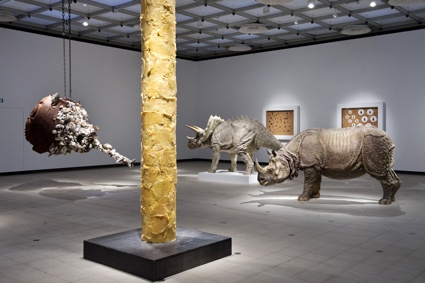 Installation view of works by Sun Yuan and Peng Yu, Photo Linda Nylind
Installation view of works by Sun Yuan and Peng Yu, Photo Linda Nylind
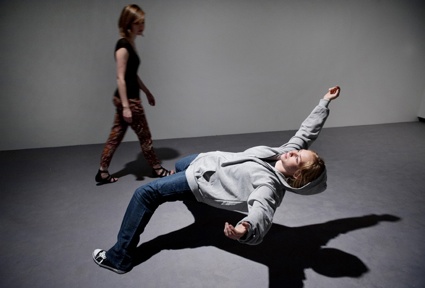 Xu Zhen, In Just a Blink of an Eye, 2005, 2012. Photo Linda Nylind
Xu Zhen, In Just a Blink of an Eye, 2005, 2012. Photo Linda Nylind
A week or so ago, i attended the press view of Art of Change: New Directions from Chinaat the Hayward gallery in London. The exhibition that brings together the work of some of the most innovative artists from the 1980s to today. Each of them is allocated one room to demonstrate the state of installation and performance art in China.
According to Curator Stephanie Rosenthal, China doesn’t have a long tradition of performance art. The art form began to flourish in the late 1970s when the country opened up towards more avant-garde forms of culture but the State banned it after the protests on Tiananmen Square. And because neither performance nor installation art are supported by the governmental art system, artists often had to work under the radar.
The works exhibited by the 9 participating artists are extremely strong. As much as i admire Ai Weiwei and his opinion of the show, i do believe that artists can create meaningful, valid works even if they are not openly criticizing their country’s politics. Besides, some of the works exhibited did comment on political issues such as censorship and international relationships. Ai Weiwei is probably right though when he writes that “The Chinese art world does not exist.” At least probably not in a uniformed, self-conscious fashion.
I don’t know how typically Chinese the works in the exhibition are but i do know that they give a dimension to contemporary art from China that had been ignored by the blockbuster exhibitions that opened in Europe -from the Saatchi gallery in London to the Cobra Museum in Amsterdam- a few years ago. For a moment, it looked as if European audiences couldn’t get enough of contemporary Chinese paintings and sculpture (custom-)produced to delight rich “Western” collectors in search of the exotic and of a good story of censorship. The works exhibited at the Hayward are certainly less market-savvy, they are less about the final product and more about creating a platform for thinking.
Change, and the acceptance that everything is subject to change, are deeply rooted in Eastern philosophy. The exhibition focuses on works that deal with transformation, instability and discontinuity, looking at how these themes are conveyed through action or materials.
My main criticism is with the archive that charts the key moments in performance and installation art from China. The archive is distributed in the gallery on posters and digital screens. Why this valuable resource is confined to the gallery space and isn’t available online for people to read and comment is a mystery to me.
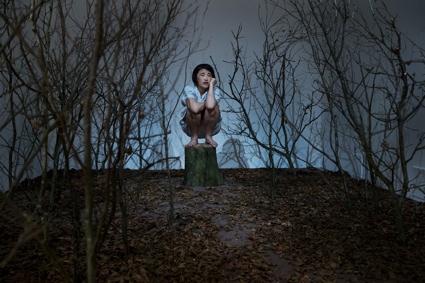 Yingmei Duan, Happy Yingmei, 2011, 2012. Photo Linda Nylind
Yingmei Duan, Happy Yingmei, 2011, 2012. Photo Linda Nylind
The most moving work for me was Yingmei Duan‘s Happy Yingmei. Visitors have to bend down to enter a small room turned into a forest. The artist was waiting at the back of the room. She was sitting and singing what sounded like a lullaby. She then raised up and walked towards me, dead leaves rustling beneath her bare feet. She was looking at me and i couldn’t move nor look away from her gaze. As she advanced towards me, i kept wondering “what will she do? how should i react?” You need to go and experience the work for yourself if you want an answer.
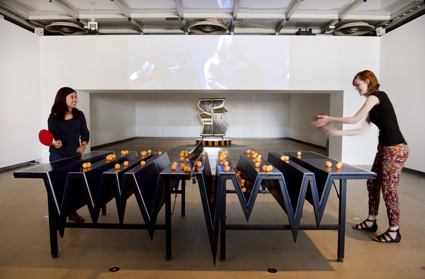 Wang Jianwei, Surplus Value, 2010. Photo Linda Nylind
Wang Jianwei, Surplus Value, 2010. Photo Linda Nylind
Wang Jianwei’s Surplus Value invites visitors to grab a racket and play ping-pong on a wonky table. Endless frustrating fun. I do suspect however that if you’re an extremely talented player you might be able not to make a fool of yourself.
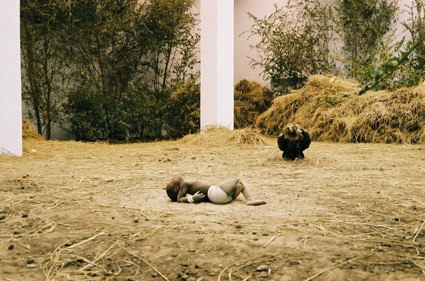 Xu Zhen, The Starving of Sudan, 2008
Xu Zhen, The Starving of Sudan, 2008
Xu Zhen’s video The Starving of Sudan recreated Kevin Carter’s 1993 Pulitzer Prize winning image of a vulture waiting by a starving child in the desert. In Xu Zhen’s version however, the child was from an immigrant Guinean family living in Guangzhou (she was supervised by her mother who was paid by the artist), and the vulture was stuffed. Visitors and members of the press who saw the performance in 2008 Beijing’s Long March Space were placed in the position of a news photographer in a war zone. They recoiled in horror but still took pictures and discussed the work on their blogs. Who’s the vulture?
Talking to art.it, the artist explained that the work is about making the audience use their own knowledge to produce a judgment. So at Long March the audience were in the same role as Kevin Carter. They went to the show, took out their cameras, shot pictures and I’m sure were very excited. Then afterwards they could pass judgment on me – “Oh, this artist is no good.” And that parallels the fact that when Kevin Carter died, he was under a lot of pressure – condemned by the whole world; but the whole world does exactly the same thing that it condemns.
The work was created soon after China entered into controversial trade and agreements with African countries, including Sudan.
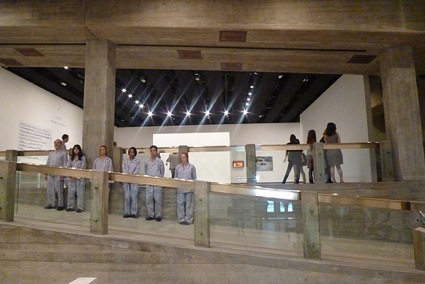 Xu Zhen, March 6
Xu Zhen, March 6
Xu Zhen also placed performers wearing striped pajamas in a neat line near the entrance of the exhibition. The actors pick up a visitor and follow them wherever they go.
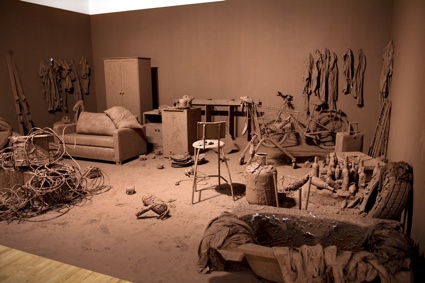 Chen Zhen, Purification Room, 2000, 2012. Photo Linda Nylind
Chen Zhen, Purification Room, 2000, 2012. Photo Linda Nylind
Chen Zhen covered a roomful of household objects with a layer of red mud. The clay dries as the exhibition progresses. According to the artist, the clay has the ability to purify and disinfect the materialist culture of objects, giving them a “new destiny”.
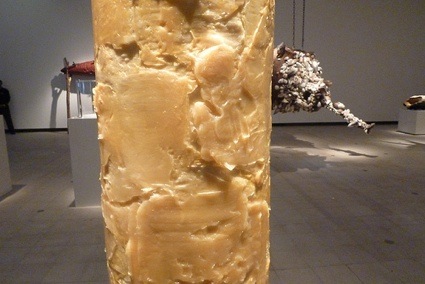 Sun Yuan and Peng Yu‘s Civilisation Pillar is a monument to capitalism, vanity and excess. The structure is made of the fat collected from plastic surgery clinics.
Sun Yuan and Peng Yu‘s Civilisation Pillar is a monument to capitalism, vanity and excess. The structure is made of the fat collected from plastic surgery clinics.
More ping-pong and more images from the exhibition:
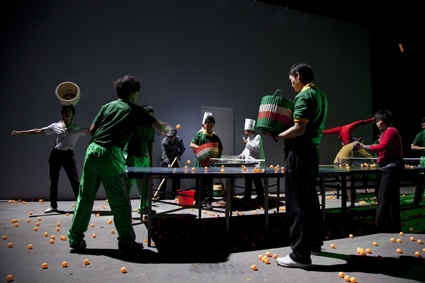 Wang Jianwei, Making do with Fakes, 2011
Wang Jianwei, Making do with Fakes, 2011
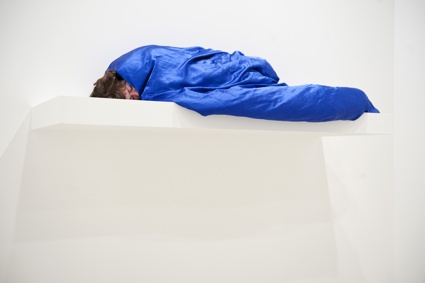 Yingmei Duan, Sleeping, 2004, 2012. Photo Linda Nylind
Yingmei Duan, Sleeping, 2004, 2012. Photo Linda Nylind
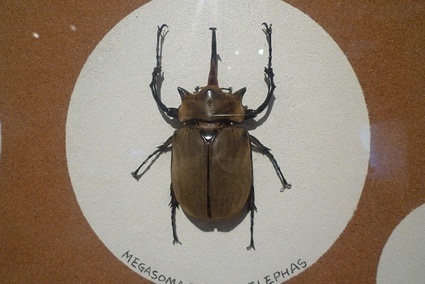 Sun Yuan and Peng Yu, I didn’t Notice What I am Doing, 2012
Sun Yuan and Peng Yu, I didn’t Notice What I am Doing, 2012
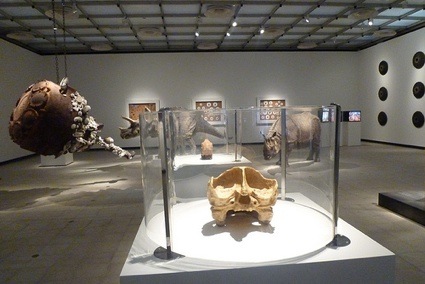 Sun Yuan and Peng Yu, I didn’t Notice What I am Doing, 2012
Sun Yuan and Peng Yu, I didn’t Notice What I am Doing, 2012
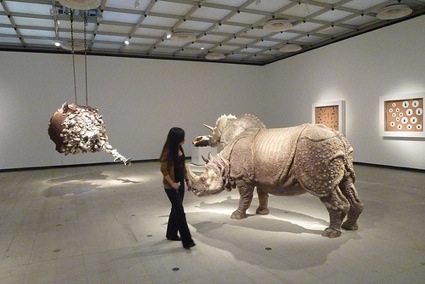 Sun Yuan and Peng Yu, I didn’t Notice What I am Doing, 2012
Sun Yuan and Peng Yu, I didn’t Notice What I am Doing, 2012
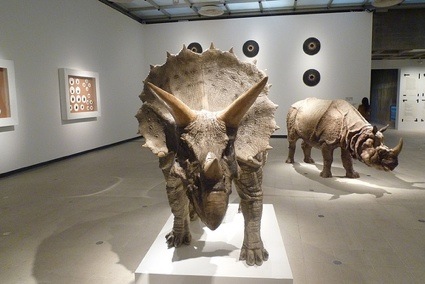 Sun Yuan and Peng Yu, I didn’t Notice What I am Doing, 2012
Sun Yuan and Peng Yu, I didn’t Notice What I am Doing, 2012
Another mag has an interview with Stephanie Rosenthal, Chief Curator, Hayward Gallery.
Art of Change: New Directions from China is at the Hayward Gallery until 9 December 2012.
Image on the homepage: Sun Yuan and Peng Yu, I didn’t Notice What I am Doing, 2012.
